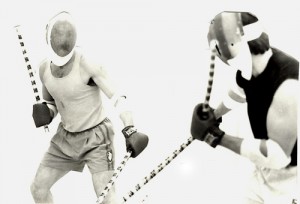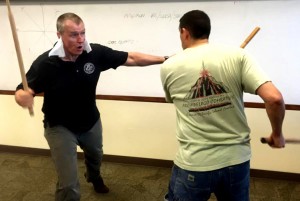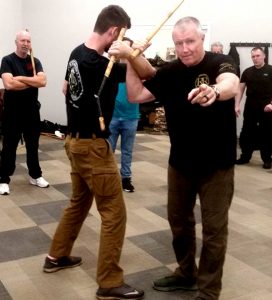When was this? This big, “Filipino martial arts turning point” for me? Keep in mind, this is just me and my personal view on things. Don’t hate me cuz I’m viewtiful!
I started doing FMA in 1986, in among other arts like JKD, and had been doing the classic karate and jujitsu (not the Brazilian wrestling version of today). By about 1993 I had covered a lot of FMA material, been to the Philippines twice. Got black belts from both Ernesto Presas and Remy Presas.
The big turning point came with double sticks, of all odd, obscure things. In 1993, a friend called me and said, “Hey Hock, this weekend, Guro ______ is coming into Dallas! He is going to do two full days of the ______ double stick drills. Are you coming?”
Two full days of…double sticks? I guess this phone call had an epiphany moment for me when several ideas flashed through my head. I found myself confessing…
“Two days? Double sticks? Well, I think I’ll pass. I mean, how many double stick drills are there anyway?”
“You’re gonna miss it! A chance to learn THEE _______ double stick drills!”
When we hung up, I examined my epiphany moment. Well, from the Inosanto world, the Remy Presas world, and Ernesto Presas world, I’d already collected about 50 double stick drills according to my anal retentive lists I keep. FIFTY ! I suddenly asked myself,
- “Why am I doing this?”
- “How many more double stick drills could there be, anyway?”
- “How different could they be after a certain basic point?”
- “What makes them different and worth knowing?”
- “How are they the same?”
How ARE they the same? I realized that it was more important to organize the drills, not from the hero-worship-“who” or the hero worship-“what” fan club systems, but instead how are the drills all the same? (It is counter productive and stifling to worship system-heads and systems.)
How are they so similar. And how and why am I wasting my time collecting endless double stick drills from a nearly endless group of known and unknown system-heads who all think theirs are ever-so-special. Many of which are so much the same and with only one slight different tweak here or there. Rather, smarter, I should instead try to understand the essence of all of them. The essential core. Then, teach the universal core.
I was already contemplating the differences between the Remy and Ernesto double stick programs. Remy seemed to have 5 or 6 basic patterns with variations. Ernesto had the classic “must know” list.
Then…then I asked myself why I didn’t view ALL aspects of the varied FMAs the same way? Why not find the universal core of FMA itself? Find the very of essence…
- mano-mano
- single stick
- knife
- double weapons
…in this clean, kind of scientific manner? Study these cores first. Deal with the needed and dismiss the probably unneeded and-or redundant and-or prissy variables.

There will always be happy museum and happy history collectors, who collect ANYTHING from ANYBODY. And then those who like to sort-of, name-drop stuff like – “at this point, Roohan moved his kneecap this way, while Roohan kept his meniscus right here…” I can talk some of that artsy smack too, just from training years osmosis. I can delight the esoteric fanatics with these tidbits of meniscus positioning. I can also tell you that Ed Kranepool played first base for the Mets in the 1960s. Hey! I do know stuff! But how useful is it?)
Annnnd with that idea? I started constructing the generic PAC course. Pacific Archipelago Concepts, an irreverent, skeptical look at the related core of those related arts. This includes all the big systems in the Pacific Ocean. A lot of this work had been done, like with Kajukenbo (karate, jujitsu, kenpo, boxing).
This clean, generic, non-worship approach did not make me popular with some existing FMA entities, (some are cult-like) in fact I was suddenly shunned by some. And in the seminar business, it is still not my most popular or even my favorite course to teach, as I usually cover generic “combatives” for lack of a better term. But hey, FMA is fun to do, good exercise, a hobby with numerous abstract mental and physical benefits. And when asked to, I will happily cover it. I feel like if I can spread the core-foundation. Then anyone can more quickly blend into any FMA system they wish to pursue.
(By the way, I carried this “core” perspective over to combatives. In a way, this “double stick epiphany” in 1993 was an important idea in more ways than one. It gave me a mission. A purpose. A vision if you will. My pursuit, my study, my interest, my goal, is the universal generic.)
Back to 1993! I later asked that friend back in 1993,
“How was the _______ double stick seminar?”
“It was great!” he said, “We did 30 drills. Most of them we already do, others just a little different here and there.”
Already do? Imagine that!
********
Hock’s email is hock@hockscqc.com
Get the full info on the PAC-FMA course right here, click here

